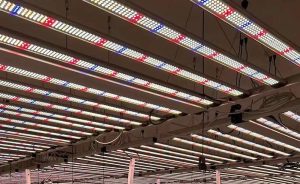
Boosting Plant Health and Food Quality with LED Grow Lights: The Power of UV and Full Spectrum
In the world of indoor gardening and professional horticulture, grow lights have become indispensable for maximizing plant quality and yield. For both home gardeners and commercial growers, the right horticulture grow light—especially a full spectrum LED grow light—can make all the difference in plant health, flavor, nutrient quality, and overall resilience. Recently, UV lighting has gained attention as a scientifically backed tool that enhances these outcomes, complementing the standard spectrum of light provided by full spectrum LED grow lights. Here, we’ll explore how LED grow lights can support a thriving indoor garden and the scientific basis behind the benefits of UV-enhanced lighting.
Why Grow Light Spectrum Matters in Horticulture
LED grow lights have evolved significantly, now allowing us to simulate sunlight’s effects and expand plant growth potential. Unlike traditional lights, full spectrum LED grow lights can target specific light wavelengths, promoting various stages of plant growth and health. Each spectrum—blue, red, and even UV—plays a distinct role:
-
Blue light encourages vegetative growth and leaf expansion.
-
Red light stimulates flowering and fruit production.
-
UV light enhances defense mechanisms, quality, and nutritional value.
Studies have shown that using the full spectrum of light, including UV, mimics natural sunlight more closely, which improves plant quality and yields. By integrating full spectrum LED grow lights with UV, you can potentially enhance the taste, nutrient content, and even the disease resistance of plants.
The Role of UV Light in LED Grow Lights: A Closer Look
Adding UV light to LED grow lights offers a range of benefits. Studies have shown that controlled exposure to UV light can increase plants’ production of beneficial compounds like antioxidants and vitamins. When combined with full spectrum LED grow lights, UV light has been found to:
-
Improve Nutrient Density: UV light can increase compounds like anthocyanins and flavonoids, which are known for their antioxidant properties. These compounds are linked to greater health benefits for consumers, offering growers an edge in producing high-value, nutrient-rich crops.
-
Enhance Disease Resistance: Just as UV light prompts our bodies to produce vitamin D, it can trigger defense mechanisms in plants. By boosting secondary metabolites, plants can become more resistant to pathogens, reducing the need for pesticides and supporting organic, sustainable growing practices.
-
Boost Taste and Aroma: Higher levels of flavonoids and terpenes are linked to enhanced taste and aroma profiles, especially in edible herbs and flowers. Gardeners and growers who incorporate UV-inclusive full spectrum LED grow lights often report that their plants produce richer, more intense flavors.
Choosing the Right Full Spectrum LED Grow Light
When selecting a grow light, understanding the impact of each light spectrum on plant health can help you choose the best tool for your horticultural needs. Some factors to consider:
-
Full Spectrum Coverage: Not all LED grow lights offer the same spectral range. To mimic natural sunlight and support different growth stages, look for lights labeled as “full spectrum.”
-
UV-Enhanced Options: Many LED grow lights now offer UV-enhanced options. If you’re interested in boosting plant resilience and nutrient quality, consider models that include UV-A light to see these benefits in your garden.
-
Energy Efficiency: The best LED grow lights are both effective and efficient, balancing light output with energy savings. Full spectrum LED grow lights offer higher efficiency than traditional lighting, which means less electricity use and lower costs in the long run.
Using UV Light Safely in Horticulture Grow Lights
While UV light has many benefits, it’s crucial to handle it safely to protect plants, people, and equipment. Excessive UV exposure can harm plants, potentially stunting growth or causing leaf burns. Here are some safety tips:
-
Start with Low Exposure: If you’re new to using UV light, introduce it gradually to your plants. Even minimal exposure can enhance quality without risking overexposure.
-
Use UV-Specific LED Grow Lights: High-quality full spectrum LED grow lights with built-in UV lighting are designed to deliver safe, optimal levels of UV, so you don’t have to worry about accidentally overdoing it.
-
Follow Manufacturer Guidelines: Every grow light model is different, so be sure to read and follow any guidelines specific to your LED grow light.
The Future of LED Grow Lights and UV Technology in Horticulture
As indoor growing technology advances, the integration of UV light in horticulture grow lights could become a game-changer, helping growers produce plants with superior taste, nutrients, and resilience. For growers seeking the best quality in fruits, vegetables, and herbs, LED grow lights with a full spectrum, including UV, offer the closest experience to natural sunlight.


No Comments